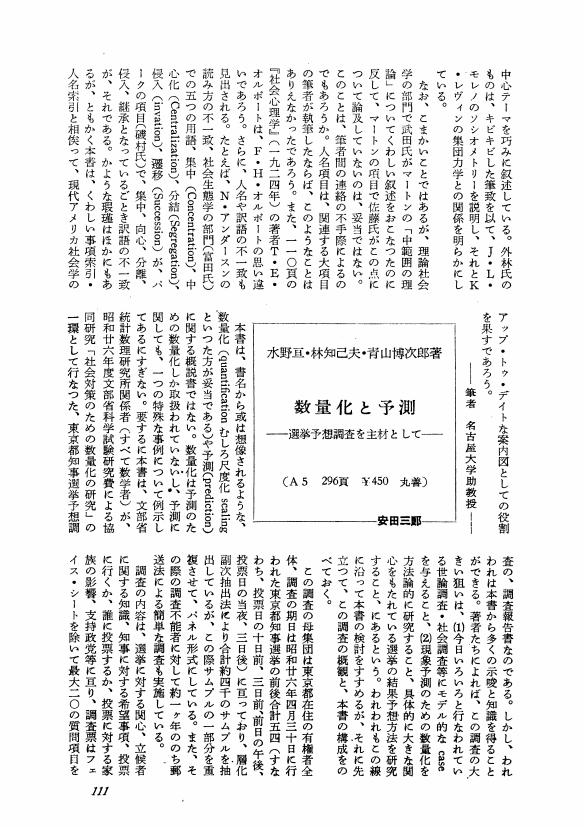4 0 0 0 OA 士族と社会移動
- 著者
- 安田 三郎
- 出版者
- The Japan Sociological Society
- 雑誌
- 社会学評論 (ISSN:00215414)
- 巻号頁・発行日
- vol.19, no.4, pp.21-40,104, 1969-03-30 (Released:2010-02-05)
- 参考文献数
- 59
The Meiji Restoration in 1868 emancipated Japan from feudal estate system. It is well known that the new Meiji government endevored to dissolve the discrimination based on feudal estate system and more than ninety percent of the total population was made to be equal, social as well as legally, although not economically, within a relatively short time. However, our nation-wide sample survey of 1965, which offers us for the first time after 1904 figures concerning to population distribution of Samurai descendants and commoners, revealed that substantial difference between Samurai descendants and commoners still exists. The proportion of Samurai descendants occupying the higher position in occupation, education, and income is larger than that of commoners, although the differences are smaller in the present generation than in the preceding ones. Why does social superiority, although not outstanding, of Samurai descendants still exist after one handred years since legal discrimination was abolished ? The answer would be divided into two parts. The first part of my answer is that any revolutionary social change cannot entirely destory the old social class structure immediately, and this might be applied to the Meiji Restoration. Let us assume that intergenerational mobility makes a Markov chain with two stages, high and low statuses : and that the above transition probability matrix P works commonly in Samurai descendants and in commoners after modern revolution like the Meiji Restoration. It is demonstrated according to the property of the regular Markov chain that if the proportion of an estate occupying the higher position is larger than that of the other estates in the initial stage of a Markov chain, the difference does not vanish within a few stages, although it reaches null after enough many stages.The second part of the answer is that the transition probability matrix P is not common in Samurai descendants and in commoners, but the matrix is more advantageous for Samurai descendants than for commoners. Our sample survey conducted in 1964 in Tokyo revealed percentages of mobility-oriented responses to various kinds of attitude questions and scales by the distinction of Samurai descendants and commoners, taking account of the influence from present occupation. One can say through sign test that Samurai descendants are statistically significantly more mobility-oriented than commoners.
2 0 0 0 OA 社会学における統計的手法の展開
- 著者
- 原 純輔 安田 三郎
- 出版者
- 応用統計学会
- 雑誌
- 応用統計学 (ISSN:02850370)
- 巻号頁・発行日
- vol.2, no.3, pp.119-136, 1973-10-20 (Released:2009-12-02)
- 参考文献数
- 58
社会学の学問的性格と,社会学的データの諸特徴のゆえに,一方において社会学における統計的方法の応用には自ら限界があるとともに,他方において社会学独自の諸方法も開発されるようになった.社会学データの源泉が主として社会調査に限定されるため,非実験データからの因果推論法としてパス・アナリシスが発達した.計量困難という特徴からは,一方で社会測定の諸方法が案出されるとともに,他方で属性の多変量解析法が考案された.データが個人と社会の2水準にまたがる点,からは,エコロジカル相関や構造効果の問題が出てくる.それらの諸展開のうち,本稿の後半ではパス・アナリシスをやや詳しく紹介する.それは重回帰分析の一種とみなしうる統計解析の一手法であるが,標準化された変数による連立方程式の逐次的システムを考えることにより,諸要因間の因果関係の強さを解明することができる.序数型データやパネル調査データへの適用も紹介する.3,4節は原が,残りを安田が執筆し,全体の調整は共同して行なった.
1 0 0 0 OA 質的データの分析と数量的分析
- 著者
- 安田 三郎
- 出版者
- The Japan Sociological Society
- 雑誌
- 社会学評論 (ISSN:00215414)
- 巻号頁・発行日
- vol.21, no.1, pp.78-85,114, 1970-07-30 (Released:2009-11-11)
- 参考文献数
- 2
- 被引用文献数
- 1
1 0 0 0 OA 水野亘・林知己夫・青山博次郎著 数量化と予測
- 著者
- 安田 三郎
- 出版者
- 日本社会学会
- 雑誌
- 社会学評論 (ISSN:00215414)
- 巻号頁・発行日
- vol.5, no.1, pp.111-113, 1954-10-20 (Released:2009-11-11)
1 0 0 0 OA 或るサムプリング調査の報告
- 著者
- 安田 三郎
- 出版者
- The Japan Sociological Society
- 雑誌
- 社会学評論 (ISSN:00215414)
- 巻号頁・発行日
- vol.3, no.4, pp.114-130, 1953-09-25 (Released:2009-11-11)
This article is a preliminary report of a joint survery conducted in 1952 by seven investigators including the authors.The questionnaire used consisted of six sections, e.g. : (a) items relating to the authoritarian personality, (b) politico-economic orientation, (c) class identification, (d) social grading of occupation, (e) spatial mobility, (f) face-sheet.The population from which the sample for this survey was drawn is the adult male population of approximately 2, 500, 000 individuals living in the urban districts of the Tokyo metropolis.Considerations which entered into the decision concerning sample size were : (a) the precision of the estimate, (b) the precision of the test of significance, and (c) the limitation of the time and financial resources. The size thus determined wes 700.Stratified sub-sampling and double sampling were used. The population was divided into 70 strata according to the type of industry and social characteristics of each districts. One primary sampling unit (cho or chôme-street) from each stratum was selected by probability-proportionately and from there 70 primary sampling units 40 male adults in proportion to the size of each stratum were obtained. These adults were again stratified according to age, occupation, and the characteristics of their dwelling place, and the final sample of 700 was obtained at a sampling ratio of 4.5 Population from which the sample was drawn was inferred from the registry of family cards.Fieldwork was conducted through the use of the house-to-house interview method and 534 person's in the sample (%) were interviewed. In order to estimate the effect of failure to interview a portion of the sample, the age-and occupation-composition of the non-interviewed group was examined and the “quasi-re-survey” method was utilized. This examination shows that deviation due to non-interviewing of a portion of the sample was negligible.The theoretical framework and the results of this survey will be reported in the following issues by individual invertigators.
1 0 0 0 社会移動に関する欲望満足延期説の検討
- 著者
- 安田 三郎
- 出版者
- 日本社会学会
- 雑誌
- 社会学評論 (ISSN:00215414)
- 巻号頁・発行日
- vol.15, no.4, pp.2-13, 1965-03-30
1 0 0 0 OA ラザースフェルトの潜在構造理論
- 著者
- 安田 三郎
- 出版者
- 日本社会学会
- 雑誌
- 社会学評論 (ISSN:00215414)
- 巻号頁・発行日
- vol.4, no.1-2, pp.190-194, 1954-01-30 (Released:2009-10-20)


